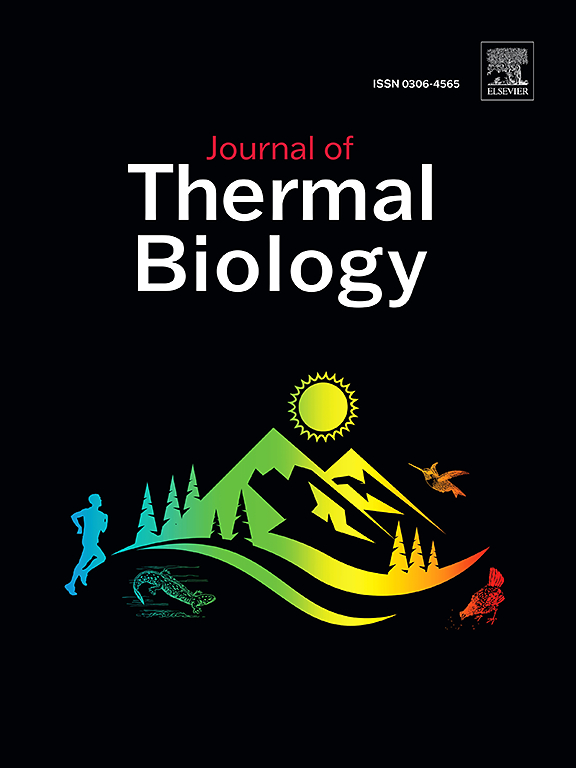热应激与肺炎克雷伯菌所致乳腺炎对大鼠炎症反应及血乳屏障的协同作用
IF 2.9
2区 生物学
Q2 BIOLOGY
引用次数: 0
摘要
由肺炎克雷伯菌引起的牛乳腺炎的发病率在夏季增加。本实验旨在从炎症反应和屏障功能方面阐明热应激与肺炎克雷伯菌诱导的乳腺炎之间的联系。从产后第9-16天开始,将泌乳大鼠白天暴露于35℃,晚上暴露于29℃,建立热应激模型。热应激处理第8天,通过乳管感染肺炎克雷伯菌建立大鼠乳腺炎模型。感染后12 h,检测直肠温度、血清生化、肺炎克雷伯菌负荷、乳腺组织病理学、上皮完整性、炎症反应、HSP70表达。结果表明,肺炎克雷伯菌感染热应激大鼠直肠温度升高,中性粒细胞浸润增多,腺泡腔病理损伤更明显。热应激通过加速NF-κB通路的激活和HSP70的表达,促进了肺炎卡伯菌感染后炎症参数(内毒素、MPO、IL-1β、IL-6和TNF-α)的产生增加,从而促进了紧密连接结构完整性的破坏和相关蛋白表达(ZO-1、Occludin和Claudin-3)的下调。因此,热应激破坏了乳腺上皮的完整性,促进了病原体的侵袭,并通过促进屏障破坏和炎症反应加重了肺炎克雷伯菌乳腺炎期间的乳腺内损伤,从而可能引发更严重的乳腺炎。本文章由计算机程序翻译,如有差异,请以英文原文为准。
Synergistic effects of heat stress and mastitis induced by K. pneumoniae on inflammation responses and blood-milk barrier in rats
The incidence of bovine mastitis caused by K. pneumoniae increases during summer. This experiment aimed to clarify the connection between heat stress and K. pneumoniae-induced mastitis in terms of inflammatory responses and barrier function. From day 9–16 of the postpartum period, lactating rats were exposed to 35 °C in the daytime and 29 °C at night to establish a heat stress model. On day 8 of the heat stress treatment, the rat mastitis model was established by intramammary infection with K. pneumoniae through the milk ducts. At 12 h post-infection, the rectal temperature, serum biochemistry, K. pneumoniae burden, as well as histopathology, epithelium integrity, inflammatory response, and HSP70 expression of the mammary glands were detected. The results showed that heat-stressed rats with K. pneumoniae infection displayed higher rectal temperatures, more neutrophil infiltration, and more significant pathological damage to the acinar lumen. Heat stress promoted the disruption of the structural integrity of tight junction and the downregulation of relative protein expressions (ZO-1, Occludin, and Claudin-3) as a consequence of the increased production of inflammatory parameters (endotoxin, MPO, IL-1β, IL-6, and TNF-α) by accelerating NF-κB pathway activation and HSP70 expression after K. pneumoniae infection. Thus, heat stress disrupts mammary epithelium integrity, contributing to the pathogen invasion, and aggravates intramammary damage during K. pneumoniae mastitis by facilitating barrier disruption and inflammatory response, which could trigger more severe mastitis.
求助全文
通过发布文献求助,成功后即可免费获取论文全文。
去求助
来源期刊

Journal of thermal biology
生物-动物学
CiteScore
5.30
自引率
7.40%
发文量
196
审稿时长
14.5 weeks
期刊介绍:
The Journal of Thermal Biology publishes articles that advance our knowledge on the ways and mechanisms through which temperature affects man and animals. This includes studies of their responses to these effects and on the ecological consequences. Directly relevant to this theme are:
• The mechanisms of thermal limitation, heat and cold injury, and the resistance of organisms to extremes of temperature
• The mechanisms involved in acclimation, acclimatization and evolutionary adaptation to temperature
• Mechanisms underlying the patterns of hibernation, torpor, dormancy, aestivation and diapause
• Effects of temperature on reproduction and development, growth, ageing and life-span
• Studies on modelling heat transfer between organisms and their environment
• The contributions of temperature to effects of climate change on animal species and man
• Studies of conservation biology and physiology related to temperature
• Behavioural and physiological regulation of body temperature including its pathophysiology and fever
• Medical applications of hypo- and hyperthermia
Article types:
• Original articles
• Review articles
 求助内容:
求助内容: 应助结果提醒方式:
应助结果提醒方式:


